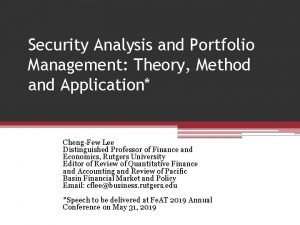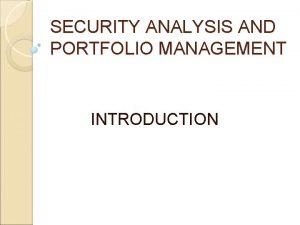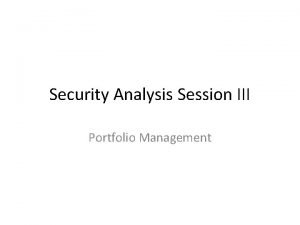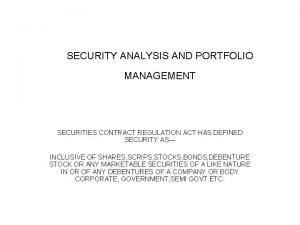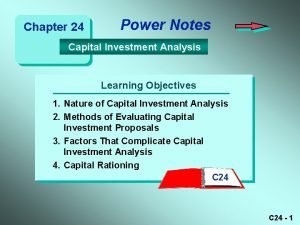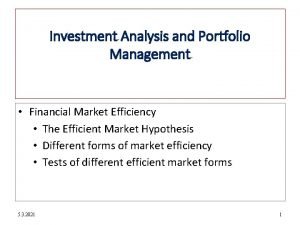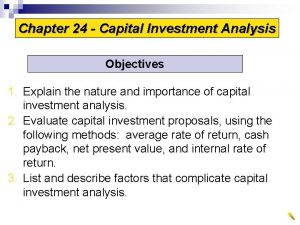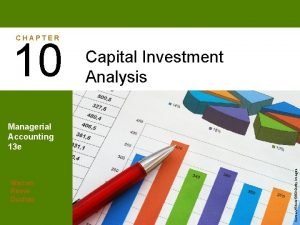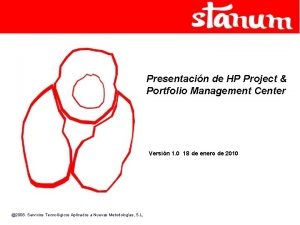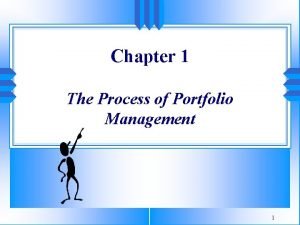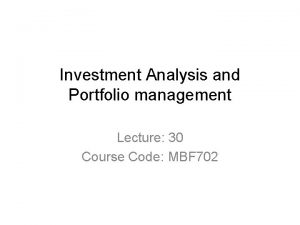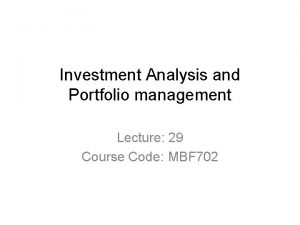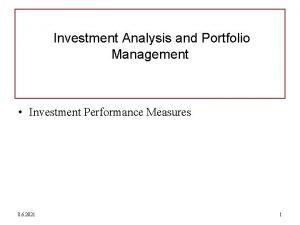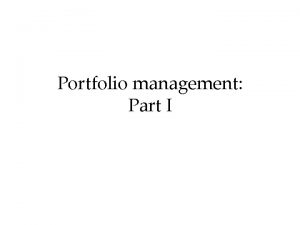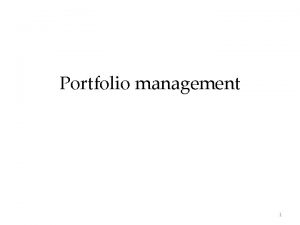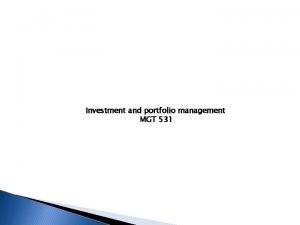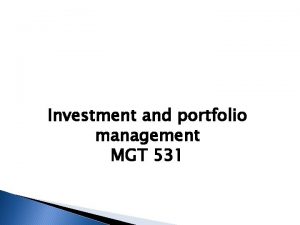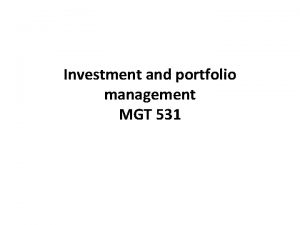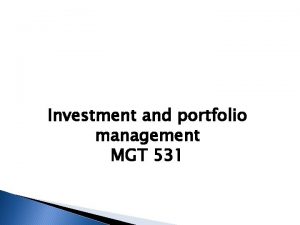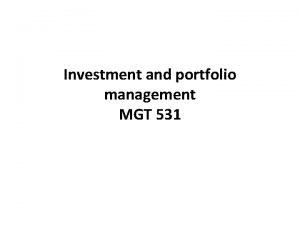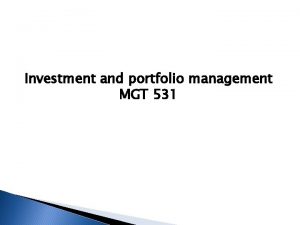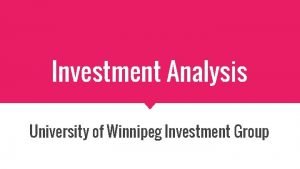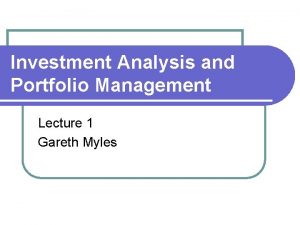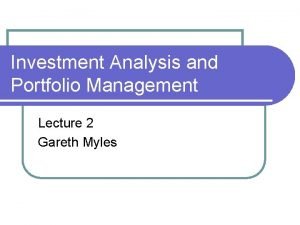Investment Analysis and Portfolio management Lecture 23 Course























- Slides: 23

Investment Analysis and Portfolio management Lecture: 23 Course Code: MBF 702

Outline • • • RECAP MM Theory Continued Arbitrage Gain Objective Portfolio Objective Introduction Return Stock returns Portfolio proportion Mean return

MM Theory Continued The logical conclusions to be drawn from MM's theory with tax is that there is an optimal gearing level and that this is at 99. 9% debt in the capital structure. • This implies that the financing decision for a company is vital to its overall market value and that companies should gear up as far as possible. . • This is not true in practice; companies do not gear up to the hilt. Why not? • In practice there are obviously many other factors that will limit this conclusion. These factors include • the costs of financial distress; • the existence of not only corporate tax but also personal taxes; • Thus in practice there a series of factors that a company will need to consider in deciding how to raise finance.

Arbitrage Gain • Arbitrage Gain: “Gain made without incurring additional risk / maintaining risk profile same”

Practical considerations in choosing a gearing level These will include: • • • Business risk of the assets; Type and quality of the assets; Expected growth; Tax position of the shareholders and debt holders. Internal and external limits to debt availability; Tax exhaustion. Agency costs Issue costs Market sentiment.

• These problems are particularly difficult for unquoted companies who have no share to draw on and possibly irregular dividend payments. In this case it would be advisable to use the WACC of a quoted company adjusted for some risk premium. • Similar problems apply to the Government. In practice the Government will set a discount rate but alongside the calculations will be a substantial cost benefit exercise to appraise the non financial benefits.

Conclusion – WACC and MM There exist in real life very great problems in estimating discount rate. WACC can be used only in situations where the new project will not materially affect the company’s gearing, and even where this is the case it is only an indicator.

Focus – WACC and MM You should now be able to: • understand the weighted average cost of capital, how it is estimated and when it should be used; • discuss theories of Modigliani and Miller, their assumptions, implications and limitations. • evaluate the impact of varying capital structures on the cost of capital.

Objective To understand portfolio theory and its relevance to decision making and financial management practice.

Introduction The first steps in investment analysis are to calculate the gains from an investment strategy and the risk involved in that strategy. Investment analysts choose to measure gains by using the concept of a return. This topic will show returns can be calculated in a variety of circumstances, both for individual assets and for portfolios. Looking back over the past performance of an investment the calculation of risk is just an exercise in computation. Given the data, the formulas will provide the answer. Where the process is interesting is when we look forward to what the return may be in the future. The challenge of investment analysis is that future returns can never be predicted exactly. The investor may have beliefs about what the return will be, but the market never fails to deliver surprises. Looking at future returns it is necessary to accommodate their unpredictability by determining the range of possible values for the return and the likelihood of each. This provides a value for the expected return from the investment. What remains is to determine just how uncertain the return is. The measure that is used to do this, the variance of return, is the analyst’s measure of risk. Together the expected return and variance of alternative portfolios provide the information needed to compare investment strategies.

Introduction At the heart of investment analysis is the observation that the market rewards those willing to bear risk. An investor purchasing an asset faces two potential sources of risk. The future price at which an asset can be sold may be unknown, as may the payments received from ownership of the asset. For a stock, both of these features are immediately apparent. The trading price of stocks changes almost continually on the exchanges. The payment from stocks comes in the form of a dividend. Although companies attempt to maintain some degree of constancy in dividends, they are only a discretionary payment rather than a commitment and their levels are subject to change. In order to guide investment choice, an invest or must be able to quantify both the reward for holding an asset and the risk inherent in that reward. They must also be aware of how the rewards and risks of individual assets interact when the assets are combined into a portfolio.

Return The measure of reward that is used in investment analysis is called the return. Although we focus on financial assets, the return can be calculated for any investment provided we know its initial value and its final value. The return is defined as the increase in value over a given time period as a proportion of the initial value. The time over which the return is computed is often called the holding period. Returns can be written in the raw form just defined or, equally well, converted to percentages. All that matters in the choice between the two is that consistency is used throughout a set of calculations. If you start using percentages, they must used everywhere. The calculations here will typically give both. The formula for calculating the return can now be introduced. Letting V 0 be the initial value of the investment and V 1 the final value at the end of the holding period, the return, r, is defined by

Return An initial investment is made of $10000. One year later, the value of the investment has risen to $12500. The return on the investment is It should be emphasized that the return is always measured relative to a time period. The example used a year as the time period, which is the conventional period over which most returns are expressed. For instance, interest rates on bonds and deposit accounts are usually quoted at an annual rate. The precise description of the return in the example is consequently that the return on the investment was 25% per year. Other time periods may be encountered such as a month, a weeks or even a day. Detailed analysis of stock prices often employs daily returns.

Return Example: An investment initially costs $5000. Three months later, the investment is sold for $6000. The return on the investment is

Stock returns This process for the calculation of a return can be applied to stocks. In doing so, it is necessary to take care with the payment of dividends since these must be included as part of the return. We first show to calculate the return for a stock that does not pay a dividend and then extend the calculation to include dividends. Consider a stock that pays no dividends for the period over which the return is to be calculated Assume that this period is one year. In the formula for the return, we take the initial value, V 0, to be the purchase price of the stock and the final value, V 1, to be its trading price one year later. If the initial price of the stock is p (0) and the final price p (1) then return on the stock is

Stock returns Example The price of Lastminute. com stock trading in London on May 29 2012 was £ 0. 77. The price at close of trading on May 28 2013 was £ 1. 39. No dividends were paid. The return for the year of this stock is given by This calculation can now be extended to include the payment of dividends. To understand the calculation it needs to be observed that the return is capturing the increase in an investor’s wealth. Since dividend payments are an addition to wealth, they need to be included in the calculation of the return. In fact, the total increase in wealth from holding the stock is the sum of its price increase plus the dividend received. So, in the formula for the return, the dividend is added to the final stock price.

Stock returns Letting d denote the dividend paid by a stock over the period under consideration, this gives the formula for the return • Example The price of IBM stock trading in New York on May 29 2012 was $80. 96. The price on May 28 2013 was $87. 57. A total of $0. 61 was paid in dividends over the year in four payments of $0. 15, $0. 15 and $0. 16. The return over the year on IBM stock was

Portfolio Return • It was noted in the introduction that the definition of a return could be applied to any form of investment, not just to individual assets. The purchase of a portfolio is an example of an investment and consequently a return can be calculated. The calculation of the return on a portfolio can be accomplished in two ways. Firstly, the initial and final values of the portfolio can be determined, dividends added to the final value and the return computed. Alternatively, the prices and payments of the individual assets, and the holding of those assets, can be used directly. Focussing first on the total value of the portfolio, if the initial value is V 0, the final value V 1 and dividends received are d, then the return is given by

Portfolio Return Example A portfolio of 200 General Motors stock and 100 IBM stock is purchased for $20696 on May 29 2012. The value of the portfolio on May 28 2013 was $15697. A total of $461 in dividends was received. The return over the year on the portfolio is

Portfolio Return The return on a portfolio can also be calculated by using the prices of the assets in the portfolio and the quantities held of each. Assume that an investor has constructed a portfolio composed of N different assets. The quantity held of asset i is ai. If the initial price of asset i is pi (0) and the final price pi (1) , then the initial value of the portfolio is

Portfolio Return If there are no dividends, then these can be used to calculate the return as

Portfolio Return Example Consider the portfolio of three stocks described in the table.

Thank you
 Investment analysis and portfolio management course
Investment analysis and portfolio management course Investment analysis and portfolio management notes for mba
Investment analysis and portfolio management notes for mba Scope of investment analysis and portfolio management
Scope of investment analysis and portfolio management Investment analysis & portfolio management
Investment analysis & portfolio management Fixed investment and inventory investment
Fixed investment and inventory investment 01:640:244 lecture notes - lecture 15: plat, idah, farad
01:640:244 lecture notes - lecture 15: plat, idah, farad Security analysis and portfolio management project
Security analysis and portfolio management project Security analysis and portfolio management project
Security analysis and portfolio management project Importance of security analysis and portfolio management
Importance of security analysis and portfolio management Risk in security analysis and portfolio management
Risk in security analysis and portfolio management Course title and course number
Course title and course number Type of portfolio
Type of portfolio Sailor course brick
Sailor course brick Chaine parallèle muscle
Chaine parallèle muscle Project planning and management lecture notes ppt
Project planning and management lecture notes ppt Financial investment analysis
Financial investment analysis Factors that complicate capital investment analysis
Factors that complicate capital investment analysis Financial investment analysis
Financial investment analysis Factors that complicate capital investment analysis
Factors that complicate capital investment analysis Factors that complicate capital investment analysis
Factors that complicate capital investment analysis Factors that complicate capital investment analysis
Factors that complicate capital investment analysis Hp project and portfolio management center
Hp project and portfolio management center Ppm tools gartner magic quadrant
Ppm tools gartner magic quadrant Portfolio construction management and protection
Portfolio construction management and protection






